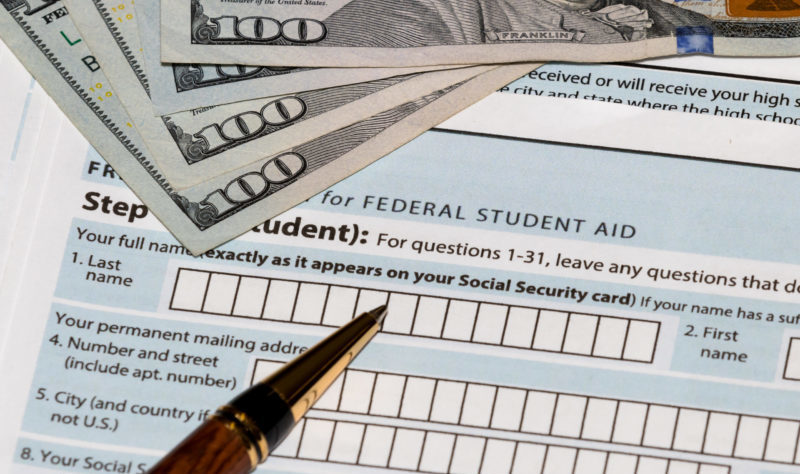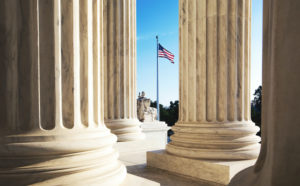
Scholars propose modifying the U.S. student loan system to remedy a debt crisis.
Politicians, educators, and financial experts agree—student loan debt in the United States is in a crisis. More than a third of U.S. adults under 30 have outstanding student loans, with a total of nearly $1.6 trillion owed by all Americans.
This number rose dramatically over the past decade and may continue to increase—especially because young adults are more likely to take out loans than were previous generations.
Although students and families can take out loans from private lenders, more than 90 percent of student loans come from the federal government. Schools consider these loans as better options for students than private loans because they have more favorable terms, such as a fixed interest rate and repayment plans that students can delay until after graduation.
Several factors have contributed to creating the modern student debt crisis. Today, more high school graduates attend college, and these new students are more likely to be from low- and middle-income families who may need loans. In addition, the U.S. Congress has lifted various limits on student lending since the 1980s, making loans more accessible to college students, graduate students, and parents.
Some politicians have also established barriers in the U.S. Bankruptcy Code to prevent student loan debt forgiveness. Although certain types of debt—such as mortgages and medical debt—can be discharged under bankruptcy, effectively cancelling their repayment, student loans presumptively remain with the borrower. To remove student loan debt, individuals declaring bankruptcy must meet a vague “undue hardship” standard that Congress has yet to define and that courts interpret differently.
Both Democrat and Republican policymakers continuously debate how to address the growing amount of student loan debt. Some politicians have proposed a variety of potential solutions, such as tying repayment to paychecks or cancelling large sums of outstanding loans.
As the Trump Administration enters its final weeks in office, and President-Elect Joe Biden prepares to enter the White House, the future of student loan debt remains uncertain. President Donald J. Trump froze student loans payments for 33 million borrowers earlier this year, a freeze that will expire on December 31 unless President Trump enacts a previously announced extension. Meanwhile, President-Elect Biden has said that he supports some sort of mass loan forgiveness as a way to kickstart the U.S. economy.
This week’s Saturday Seminar examines student loan debt in the United States and different approaches to addressing this crisis.
- Courts should relax their interpretation of the Bankruptcy Code’s undue hardship standard for discharging student loan debt, attorney Alexander Gouzoules argues in an Emory Law Journal Online article. He proposes reevaluating this standard to include health insurance status—which is especially important during the COVID-19 pandemic as health care costs may rise and more Americans could become bankrupt if the economy continues to struggle. Gouzoules writes that “debtors without access to health care necessarily face an undue hardship warranting bankruptcy discharge of their student loans.”
- In a recent Loyola Consumer Law Review article, Seth Frotman of the Student Borrower Protection Center claims that the Consumer Financial Protection Bureau (CFPB) should prioritize enacting regulations on student loan servicing to protect current borrowers. Student loan servicers—nine of which currently dominate the market—are companies that administer student loans on behalf of the U.S. Department of Education. According to Frotman, these companies often engage in disempowering or deceiving practices such as misrepresenting late fees or illegally raising interest rates for borrowers due to the absence of uniform industry standards. Since Congress created the CFPB to protect consumers from abusive practices, Frotman contends that the agency must enact regulations to prevent worsening the student debt crisis.
- “Student debt is a civil rights issue,” Dalié Jiménez of the University of California, Irvine School of Law and Jonathan D. Glater of the University of California, Los Angeles School of Law argue in a recent Harvard Civil Rights-Civil Liberties Law Review article. Student debt disproportionately harms students of color, who are more likely to lack financial resources and take out larger student loans to attend for-profit universities that provide limited career opportunities, they claim. To bridge the gap in access to higher education, Jiménez and Glater propose cancelling student loans for current borrowers through debt forgiveness and making public universities tuition-free. These reforms, they contend, provide the federal government with a blueprint for refinancing higher education to lessen the burdens of student debt on communities of color.
- The Education Department should not fight attempts to discharge student loan debt in bankruptcy when student-debtors would “clearly” meet the undue hardship standard “if forced to continue to attempt repayment,” legal scholars argue in a recent article published in the University of Colorado Law Review. Howard University’s Matthew Bruckner, the University of Missouri’s Brook E. Gotberg, the University of California, Irvine’s Dalié Jiménez, and Rutgers University’s Chrystin Ondersma encourage the Education Department to permit discharge in certain situations. Removing student loan debt could be justified, they argue, when the borrower earns less than 1.5 times the federal poverty level and has other serious limitations, such as being a lifespan respite or designated veteran caregiver, receiving Social Security Act disability benefits, or living solely on retirement benefits. Creating clear categories for allowing borrowers to cancel student loan debt will save taxpayer money and resolve “many of the grosser inequities currently associated with restrictions on student loan discharge in the Bankruptcy Code,” the authors contend.
- In a recent Indiana Law Journal article, John P. Hunt of the University of California, Davis, School of Law criticizes the Education Department for its policy of only consenting to discharge student loan debt when collection would cost too much. Hunt argues that instead, the Education Department should introduce discharge consent guidance that aligns with “other student loan program goals,” such as “promoting equal access to education, creating a more educated population, safeguarding freedom of career choice, and benefiting borrowers generally.” This change, Hunt explains, would improve discharge rules, reflect congressional intent, and help student loan borrowers.
- The U.S. student loan system should shift from its current debt framework to a taxation-like structure, Georgetown University Law Center’s John R. Brooks and Adam J. Levitin argue in a The Georgetown Law Journal article. Describing the student loan system as “a hybrid that falls between pure debt and pure tax,” Brooks and Levitin outline a series of changes to move away from a debt framework. For example, they suggest that student borrowers should only have the option of an income-based repayment model. In addition, they propose eliminating student loan forgiveness and interest charges, stating instead that linking unpaid grants to inflation would lower the total amount that students would have to pay back. These “targeted reforms,” among other changes, would create an affordable educational landscape, according to Brooks and Levitin.
The Saturday Seminar is a weekly feature that aims to put into written form the kind of content that would be conveyed in a live seminar involving regulatory experts. Each week, The Regulatory Review publishes a brief overview of a selected regulatory topic and then distills recent research and scholarly writing on that topic.



